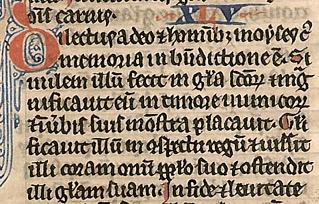Script Type : minuscule
Script Family : Gothic
Date : 13th to 15th centuries. This example is from the mid 13th century.
Location : Western Europe. This example is from France, probably Paris.
Function : Book hand, derived from the very tiny script used for glosses, used especially for miniature Bibles.



























Distinctive letters : This example is taken from a miniature Bible of the kind that were produced in considerable numbers in the 13th century. As these volumes contained the complete Old and New Testaments in a single volume that was designed to be portable, the main characteristic of the script is its compactness. The letter forms are simplified versions of Gothic textura, and as such are easy enough to read when they are isolated out. The difficulty comes from the very large amount of abbreviation, the tiny size and the way letters and words are squashed together. While letter forms are standard Gothic, they do not have formal feet, just a little upward flick at the base of the letter.
The letter d has the backsloping Gothic form while a appears to be sometimes open at the top and sometimes closed, but that may just be a factor of the very small size of the letters.
As usual in formal Gothic scripts, both the tall and the short and curly form of s are employed, and two forms of r.
The letters i and j are identical, as are u and v.
There are no examples of k or w, but y and z are represented. The y appears, mysteriously, in the name Moses, which is here spelled moyses.
Pass the cursor slowly over the lines of text to get a hint of what it is about. For a more detailed examination, proceed to the paleography exercises.
Paleography
exercises using Flash![]()
Requires at least the Flash 5 plugin
If you are looking at this page without frames, there is more information about medieval writing to be found by going to the home page (framed) or the site map (no frames).